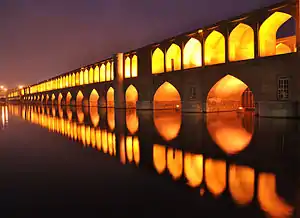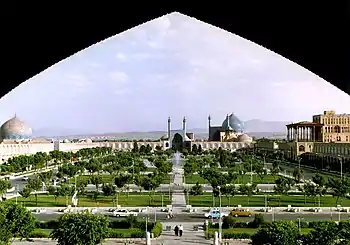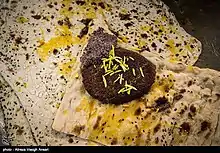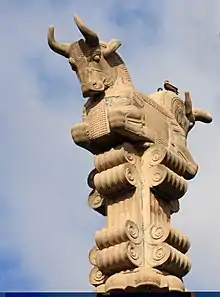Isfahan
Isfahan (Persian: اصفهان, romanized: Esfahān, [esfæˈhɒːn] (![]() listen)), historically also rendered in English as Ispahan, Spahan, Sepahan, Esfahan or Hispahan, is a major city in Iran, Greater Isfahan Region. It is located 406 kilometres (252 miles) south of Tehran and is the capital of Isfahan Province.
listen)), historically also rendered in English as Ispahan, Spahan, Sepahan, Esfahan or Hispahan, is a major city in Iran, Greater Isfahan Region. It is located 406 kilometres (252 miles) south of Tehran and is the capital of Isfahan Province.
Isfahan
اصفهان Spahān, Aspadana | |
|---|---|
City | |
   .jpg.webp)  .jpg.webp)  Top-bottom, R-L: Naqsh-e Jahan Square View from Keisaria gate, Khaju Bridge, Si-o-se-pol, Chehel Sotoun, Flower Garden of Isfahan, Hasht Behesht, Shah Mousqe | |
 Seal Ancient | |
| Nickname(s): Nesf-e Jahān (Half of the World) | |
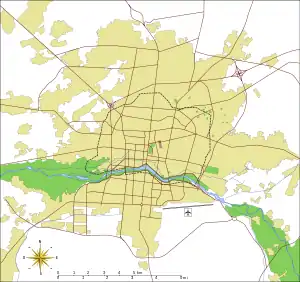 Isfahan | |
 Isfahan Isfahan in Iran 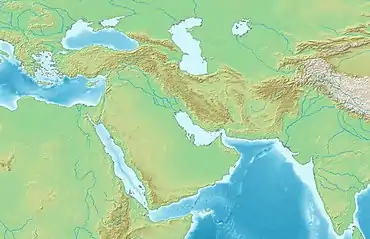 Isfahan Isfahan (West and Central Asia) | |
| Coordinates: 32°38′41″N 51°40′03″E | |
| Country | |
| Province | Isfahan |
| County | Isfahan |
| District | Central |
| Government | |
| • Mayor | Ghodratollah Norouzi |
| • City Council | Fathollah Moein (Chairman) |
| Area | |
| • Urban | 551 km2 (213 sq mi) |
| Elevation | 1,574 m (5,217 ft) |
| Population (2016 Census) | |
| • Urban | 2,000,000[2] |
| • Metro | 3,989,070[3] |
| • Population Rank in Iran | 3rd |
| Time zone | UTC+3:30 (IRST) |
| • Summer (DST) | UTC+4:30 (IRDT 21 March – 20 September) |
| Area code(s) | 031 |
| Climate | BWk[4] |
| City flower | Rosa 'Ispahan' |
| City Animal | Sheep and ram |
| Website | isfahan.ir |
| Isfahan city |
|---|
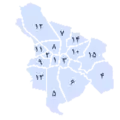 |
Isfahan has a population of approximately 2.0 million,[5] making it the third-largest city in Iran after Tehran and Mashhad, but was once one of the largest cities in the world.
Isfahan is an important city as it is located at the intersection of the two principal north–south and east–west routes that traverse Iran. Isfahan flourished from 1050 to 1722, particularly in the 16th and 17th centuries under the Safavid dynasty when it became the capital of Persia for the second time in its history under Shah Abbas the Great. Even today the city retains much of its past glory.
It is famous for its Perso–Islamic architecture, grand boulevards, covered bridges, palaces, tiled mosques and minarets. Isfahan also has many historical buildings, monuments, paintings, and artifacts. The fame of Isfahan led to the Persian proverb "Esfahān nesf-e-jahān ast": Isfahan is half (of) the world.[6]
The Naqsh-e Jahan Square in Isfahan is one of the largest city squares in the world. UNESCO has designated it a World Heritage Site.
Etymology
Isfahan is derived from Middle Persian Spahān. Spahān is attested in various Middle Persian seals and inscriptions, including that of Zoroastrian Magi Kartir,[7] and is also the Armenian name of the city (Սպահան). The present-day name is the Arabicized form of Ispahan (unlike Middle Persian, but similar to Spanish, New Persian does not allow initial consonant clusters such as sp[8]). The region appears with the abbreviation GD (Southern Media) on Sasanian numismatics. In Ptolemy's Geographia, it appears as Aspadana (Ἀσπαδανα), translating to "place of gathering for the army". It is believed that Spahān derives from spādānām "the armies", Old Persian plural of spāda, from which derives spāh (𐭮𐭯𐭠𐭧) 'army' and spahi (سپاهی, 'soldier', literally 'of the army') in Middle Persian. Some of the other ancient names include Jey, Gey, Park, Judea[9][10]
History
| Year | Pop. | ±% p.a. |
|---|---|---|
| 1870 | 60,000 | — |
| 1890 | 90,000 | +2.05% |
| 1900 | 100,000 | +1.06% |
| 1920 | 80,000 | −1.11% |
| 1933 | 100,100 | +1.74% |
| 1942 | 204,600 | +8.27% |
| 1956 | 254,700 | +1.58% |
| 1968 | 444,000 | +4.74% |
| 1976 | 671,800 | +5.31% |
| 1986 | 986,800 | +3.92% |
| 1991 | 1,182,735 | +3.69% |
| 1996 | 1,327,283 | +2.33% |
| 2001 | 1,327,283 | +0.00% |
| 2006 | 1,689,392 | +4.94% |
| 2011 | 1,853,293 | +1.87% |
| 2016 | 1,961,260 | +1.14% |
| source:[11] | ||
Human habitation of the Isfahan region can be traced back to the Palaeolithic period. Recent discoveries archaeologists have found artifacts dating back to the Palaeolithic, Mesolithic, Neolithic, Bronze and Iron Ages.
Bronze Age
What was to become the city of Isfahan in later historical periods probably emerged as a locality and settlement that gradually developed over the course of the Elamite civilisation (2700–1600 BCE).
Zoroastrian era
Under Median rule, this commercial entrepôt began to show signs of more sedentary urbanism, steadily growing into a noteworthy regional centre that benefited from the exceptionally fertile soil on the banks of the Zayandehrud River in a region called Aspandana or Ispandana.

Once Cyrus the Great (reg. 559–529 BCE) had unified Persian and Median lands into the Achaemenid Empire (648–330 BCE), the religiously and ethnically diverse city of Isfahan became an early example of the king's fabled religious tolerance. It was Cyrus who, having just taken Babylon, made an edict in 538 BCE, declaring that the Jews in Babylon could return to Jerusalem (see Ezra ch. 1). Now it seems that some of these freed Jews settled in Isfahan instead of returning to their homeland. The 10th-century Persian historian Ibn al-Faqih wrote:[12]
When the Jews emigrated from Jerusalem, fleeing from Nebuchadnezzar, they carried with them a sample of the water and soil of Jerusalem. They did not settle down anywhere or in any city without examining the water and the soil of each place. They did all along until they reached the city of Isfahan. There they rested, examined the water and soil, and found that both resembled Jerusalem. Thereupon they settled there, cultivated the soil, raised children and grandchildren, and today the name of this settlement is Yahudia.
The Parthians, in the period 247 BCE – 224 CE, continued the tradition of tolerance after the fall of the Achaemenids, fostering the Hellenistic dimension within Iranian culture and the political organisation introduced by Alexander the Great's invading armies. Under the Parthians, Arsacid governors administered the provinces of the nation from Isfahan, and the city's urban development accelerated to accommodate the needs of a capital city.

The next empire to rule Persia, the Sassanids (224 CE –651 CE), presided over massive changes in their realm, instituting sweeping agricultural reform and reviving Iranian culture and the Zoroastrian religion. Both the city and region were then called by the name Aspahan or Spahan. The city was governed by a group called the Espoohrans, who came from seven noble and important Iranian royal families. Extant foundations of some Sassanid-era bridges in Isfahan suggest that the Sasanian kings were fond of ambitious urban planning projects. While Isfahan's political importance declined during the period, many Sassanid princes would study statecraft in the city, and its military role developed rapidly. Its strategic location at the intersection of the ancient roads to Susa and Persepolis made it an ideal candidate to house a standing army, ready to march against Constantinople at any moment. The words 'Aspahan' and 'Spahan' are derived from the Pahlavi or Middle Persian meaning 'the place of the army'.[13] Although many theories have been mentioned about the origin of Isfahan, in fact little is known of it before the rule of the Sasanian dynasty (c. 224 – c. 651 CE). The historical facts suggest that in the late 4th and early 5th centuries, Queen Shushandukht, the Jewish consort of Yazdegerd I (reigned 399–420) settled a colony of Jews in Yahudiyyeh (also spelled Yahudiya), a settlement 3 km northwest of the Zoroastrian city of Gabae (it's Achaemid and Parthian name; Gabai was its Sasanic name, which was shortened to Gay (Arabic 'Jay') that was located on the northern bank of the Zayanderud River. The gradual population decrease of Gay (Jay) and the simultaneous population increase of Yahudiyyeh and its suburbs after the Islamic conquest of Iran resulted in the formation of the nucleus of what was to become the city of Isfahan. The words "Aspadana", "Ispadana", "Spahan" and "Sepahan", all from which the word Isfahan is derived, referred to the region in which the city was located.
Isfahan and Gay were both circular in design, a characteristic of Parthian and Sasanian cities.[14] However, this reported Sasanian circular city of Isfahan is not uncovered yet.[15]
Islamic era
 Isfahan, capital of the Kingdom of Persia
Isfahan, capital of the Kingdom of Persia Pont Alla from Voyage to the Levant, Guillaume Cavelier, 1714.
Pont Alla from Voyage to the Levant, Guillaume Cavelier, 1714.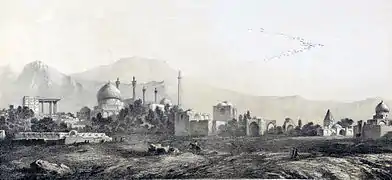 Isfahan to the south side, drawing by Eugène Flandin
Isfahan to the south side, drawing by Eugène Flandin Ali minaret, 1840, drawing by Eugène Flandin
Ali minaret, 1840, drawing by Eugène Flandin Russian army in Isfahan in the 1890s
Russian army in Isfahan in the 1890s
When the Arabs captured Isfahan in 642, they made it the capital of al-Jibal ("the Mountains") province, an area that covered much of ancient Media. Isfahan grew prosperous under the Persian Buyid (Buwayhid) dynasty, which rose to power and ruled much of Iran when the temporal authority of the Abbasid caliphs waned in the 10th century. The city walls of Isfahan are thought to have been constructed during the reign of the Buyid amirs during the tenth century.[16][17][18] The Turkish conqueror and founder of the Seljuq dynasty, Toghril Beg, made Isfahan the capital of his domains in the mid-11th century; but it was under his grandson Malik-Shah I (r. 1073–92) that the city grew in size and splendour.[19]
After the fall of the Seljuqs (c. 1200), Isfahan temporarily declined and was eclipsed by other Iranian cities such as Tabriz and Qazvin. During his visit in 1327, Ibn Battuta noted that "The city of Isfahan is one of the largest and fairest of cities, but it is now in ruins for the greater part."[20]
In 1387, Isfahan surrendered to the Turko-Mongol warlord Timur. Initially treated with relative mercy, the city revolted against Timur's punitive taxes by killing the tax collectors and some of Timur's soldiers. In retribution, Timur ordered the massacre of the city residents, and his soldiers killed a reported 70,000 citizens. An eye-witness counted more than 28 towers, each constructed of about 1,500 heads.[21]
Isfahan regained its importance during the Safavid period (1501–1736). The city's golden age began in 1598 when the Safavid ruler Shah Abbas I (reigned 1588–1629) made it his capital and rebuilt it into one of the largest and most beautiful cities in the 17th-century world. In 1598 Shah Abbas the Great moved his capital from Qazvin to the more central Isfahan; he named it Ispahān (New Persian) so that it wouldn't be threatened by the Ottomans. This new status ushered in a golden age for the city, with architecture and Persian culture flourishing. In the 16th and 17th centuries, thousands of deportees and migrants from the Caucasus, that Abbas and other Safavid rulers had permitted to emigrate en masse, settled in the city. So now the city had enclaves of Georgian, Circassian, and Daghistani descent.[22] Engelbert Kaempfer, who dwelt in Safavid Persia in 1684–85, estimated their number at 20,000.[22][23] During the Safavid era, the city contained a very large Armenian community as well. As part of Abbas's forced resettlement of peoples from within his empire, he resettled as many as 300,000 Armenians[24][25]) from near the unstable Safavid-Ottoman border, primarily from the very wealthy Armenian town of Jugha (also known as Old Julfa) in mainland Iran.[25] In Isfahan, he ordered the foundation of a new quarter for these resettled Armenians from Old Julfa, and thus the Armenian Quarter of Isfahan was named New Julfa.[24][25] Today, the New Jolfa district of Isfahan remains a heavily Armenian-populated district, with Armenian churches and shops, the Vank Cathedral being especially notable for its combination of Armenian Christian and Iranian Islamic elements. It is still one of the oldest and largest Armenian quarters in the world. Following an agreement between Shah Abbas I and his Georgian subject Teimuraz I of Kakheti ("Tahmuras Khan"), whereby the latter submitted to Safavid rule in exchange for being allowed to rule as the region's wāli (governor) and for having his son serve as dāruḡa ("prefect") of Isfahan in perpetuity, the Georgian prince converted to Islam and served as governor.[22] He was accompanied by a troop of soldiers,[22] some of whom were Georgian Orthodox Christians.[22] The royal court in Isfahan had a great number of Georgian ḡolāms (military slaves), as well as Georgian women.[22] Although they spoke both Persian and Turkic, their mother tongue was Georgian.[22] During Abbas's reign, Isfahan became very famous in Europe, and many European travellers made an account of their visit to the city, such as Jean Chardin. This prosperity lasted until it was sacked by Afghan invaders in 1722 during a marked decline in Safavid influence.
Thereafter, Isfahan experienced a decline in importance, culminating in a move of the capital to Mashhad and Shiraz during the Afsharid and Zand periods respectively, until it was finally moved to Tehran in 1775 by Agha Mohammad Khan, the founder of the Qajar dynasty.
In the early years of the 19th century, efforts were made to preserve some of Isfahan's archeologically important buildings. The work was started by Mohammad Hossein Khan during the reign of Fath Ali Shah.[26]
Modern age
 Street from above
Street from above Isfahan in 1924
Isfahan in 1924 Foolad Mobarakeh Steel Mill
Foolad Mobarakeh Steel Mill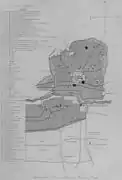 General map of Isfahan by Pascal Coste
General map of Isfahan by Pascal Coste
In the 20th century, Isfahan was resettled by a very large number of people from southern Iran, firstly during the population migrations at the start of the century, and again in the 1980s following the Iran–Iraq War.
Today, Isfahan produces fine carpets, textiles, steel, handicrafts, and traditional foods including sweets. There are nuclear experimental reactors as well as facilities for producing nuclear fuel (UCF) within the environs of the city.[27] Isfahan has one of the largest steel-producing facilities in the region, as well as facilities for producing special alloys. Mobarakeh Steel Company is the biggest steel producer in the whole of the Middle East and Northern Africa, and it is the biggest DRI producer in the world.[28] The Isfahan Steel Company was the first manufacturer of constructional steel products in Iran, and it remains the largest such company today.[29]
The city has an international airport and a metro line.
There are a major oil refinery and a large airforce base outside the city. HESA, Iran's most advanced aircraft manufacturing plant, is located just outside the city.[30][31] Isfahan is also attracting international investment,.[32] Isfahan hosted the International Physics Olympiad in 2007. 2020 Iran-Qatar Joint Economic Commission met in the city.[33]
Geography
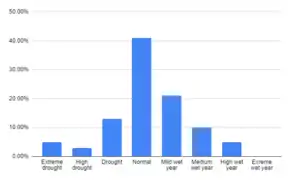
The city is located in the lush plains of the Zayanderud River at the foothills of the Zagros mountain range. The nearest mountain is Mount Soffeh (Kuh-e Soffeh), just south of the city.
Hydrography
There is an artificial network of canals whose components are called Madi which were built during the rule of Safavid dynasty for water channeling from "Zaayaandeh Roud" river into different parts of the city. Designed by Sheikh Bahaï, an engineer of Shah Abbas, this network has 77 madis on the northern part, and 71 on the southern part of Zayandeh Roud. In 1993, this centuries-old network provided 91% of agricultural water needs, 4% of industrial needs, and 5% of city needs.[34] 70 emergency wells were dug in 2018 to avoid water shortages.[35][36][37]
 Media related to Canals in Isfahan at Wikimedia Commons
Media related to Canals in Isfahan at Wikimedia Commons
Ecological issues
Towns and villages around Isfahan have been hit so hard by drought and water diversion that they have emptied out and people who lived there have moved.[38][39] An anonymous journalist said that what’s called drought is more often the mismanagement of water.[40][41][42] Subsidence rate is dire and decreases by one meter in aquifer level annually.[43] As of 2020 the city had the worst air quality between major Iranian cities.[44][45][46][47]
Flora and fauna
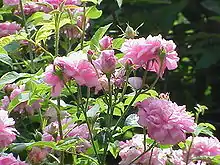
The Damask rose cultivar Rosa 'Ispahan' is named after the city. Isfahan endemic cows went extinct in 2020.[48] Wagtails are often seen in farmlands and parks.[49]
 Media related to Rosa Ispahan at Wikimedia Commons
Media related to Rosa Ispahan at Wikimedia Commons
The mole cricket is one of the major pests of plants in the soil, especially grass roots.[50][51] Sheep and rams are the animal symbol of Isfahan.[52]
Armed forces base
IRGC AF has an airbase in the city[53][54] and has been taking a cloud seeding contract project through UAVs in Isfahan.[55]
The Islamic Republic of Iran Air Force has an airbase named 8th Predator Tactical Fighter Base (TFB.8) which is the home base for Iranian F-14s.[56][57][58][59]
Sepah Pasdaran is named "Master of the Era" ("Saheb al zaman" in Arabic and Farsi) after Mahdi. On October 26th, 2020, the Ghasem Suleimani base was built for combating the COVID-19 pandemic in Isfahan.[60][61][62]

Climate
Situated at 1,590 metres (5,217 ft) above sea level on the eastern side of the Zagros Mountains, Isfahan has an cold desert climate (Köppen BWk). No geological obstacles exist within 90 kilometres (56 miles) north of Isfahan, allowing cool winds to blow from this direction. Despite its altitude, Isfahan remains hot during the summer, with maxima typically around 35 °C (95 °F). However, with low humidity and moderate temperatures at night, the climate is quite pleasant. During the winter, days are cool while nights can be very cold. Snow falls an average of 7.8 days each winter.[63] The Zayande River starts in the Zagros Mountains, flowing from the west through the heart of the city, then dissipates in the Gavkhouni wetland. Planting olive trees in the city is economically viable because it is compatible with water shortage.[64]
| Climate data for Isfahan (1961–1990, extremes 1951–2010) | |||||||||||||
|---|---|---|---|---|---|---|---|---|---|---|---|---|---|
| Month | Jan | Feb | Mar | Apr | May | Jun | Jul | Aug | Sep | Oct | Nov | Dec | Year |
| Record high °C (°F) | 20.4 (68.7) |
23.4 (74.1) |
29.0 (84.2) |
32.0 (89.6) |
37.6 (99.7) |
41.0 (105.8) |
43.0 (109.4) |
42.0 (107.6) |
39.0 (102.2) |
33.2 (91.8) |
26.8 (80.2) |
21.2 (70.2) |
43.0 (109.4) |
| Average high °C (°F) | 8.8 (47.8) |
11.9 (53.4) |
16.8 (62.2) |
22.0 (71.6) |
28.0 (82.4) |
34.1 (93.4) |
36.4 (97.5) |
35.1 (95.2) |
31.2 (88.2) |
24.4 (75.9) |
16.9 (62.4) |
10.8 (51.4) |
23.0 (73.4) |
| Daily mean °C (°F) | 2.7 (36.9) |
5.5 (41.9) |
10.4 (50.7) |
15.7 (60.3) |
21.3 (70.3) |
27.1 (80.8) |
29.4 (84.9) |
27.9 (82.2) |
23.5 (74.3) |
16.9 (62.4) |
9.9 (49.8) |
4.4 (39.9) |
16.2 (61.2) |
| Average low °C (°F) | −2.4 (27.7) |
−0.2 (31.6) |
4.5 (40.1) |
9.4 (48.9) |
14.2 (57.6) |
19.1 (66.4) |
21.5 (70.7) |
19.8 (67.6) |
15.1 (59.2) |
9.3 (48.7) |
3.6 (38.5) |
−0.9 (30.4) |
9.4 (48.9) |
| Record low °C (°F) | −19.4 (−2.9) |
−12.2 (10.0) |
−8 (18) |
−4 (25) |
4.5 (40.1) |
10.0 (50.0) |
13.0 (55.4) |
11.0 (51.8) |
5.0 (41.0) |
0.0 (32.0) |
−8 (18) |
−13 (9) |
−19.4 (−2.9) |
| Average precipitation mm (inches) | 17.1 (0.67) |
14.1 (0.56) |
18.2 (0.72) |
19.2 (0.76) |
8.8 (0.35) |
0.6 (0.02) |
0.7 (0.03) |
0.2 (0.01) |
0.0 (0.0) |
4.1 (0.16) |
9.9 (0.39) |
19.6 (0.77) |
112.5 (4.43) |
| Average precipitation days (≥ 1.0 mm) | 4.0 | 2.9 | 3.8 | 3.5 | 2.0 | 0.2 | 0.3 | 0.1 | 0.0 | 0.8 | 2.2 | 3.7 | 23.5 |
| Average snowy days | 3.2 | 1.7 | 0.7 | 0.1 | 0.0 | 0.0 | 0.0 | 0.0 | 0.0 | 0.0 | 0.2 | 1.9 | 7.8 |
| Average relative humidity (%) | 60 | 51 | 43 | 39 | 33 | 23 | 23 | 24 | 26 | 36 | 48 | 57 | 39 |
| Mean monthly sunshine hours | 205.3 | 213.3 | 242.1 | 244.5 | 301.3 | 345.4 | 347.6 | 331.2 | 311.6 | 276.5 | 226.1 | 207.6 | 3,252.5 |
| Source 1: NOAA[65] | |||||||||||||
| Source 2: Iran Meteorological Organization (records)[66][67] | |||||||||||||
Demographics
The mean of the first marriage age, for females and males in 2019 was 25 and 30 years respectively.[68][69]
Culture
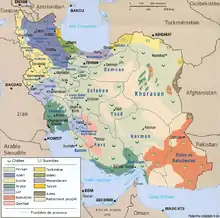
Isfahan international convention center is under construction. The Isfahan annual literature prize began in 2004.[70][71] New Art Paradise built in District 6 in 2019 has the biggest open amphitheatre in the country.[72] Since 2005, November 22nd is Isfahan's National Day commemorated with various events.[73] Based on a statue creator's symposium in 2020, the city decided to add 11 permanent art pieces to the city's monuments.[74] َAncient traditions included Tirgan, Sepandārmazgān festivals, and historically, men used to wear Kolah namadi.[75][76] The Isfahan School of painting flourished during the Safavid era.[77][78][79] The Esfahan province annual theatre festival is in this city.[80] Theater performances began in 1919 (1297 AH), and currently, there are 9 active theaters.[81][82][83]
Music
Bayat-e Esfahan is one of the melodic pieces of Iranian traditional music.

Iranian singer Salar Aghili performed in the city of Isfahan on January 12 and 13, 2018, without the female members of his band due to interference by local officials at the Ministry of Islamic Culture and Guidance.[84]
Technology, ICT and media
Atlas for Isfahan Megacity is an internet service for data and statistics in Farsi made available in 2015.[85][86][87] IRIB has a TV network and Radio channel in the city.[88] During the Qajar era, Farhang, the first newspaper publication in the city, was printed for 13 years.[89]
Philosophy and Islamic school
Some major philosophers include Mir Damad, known for his concepts of time and nature, as well as founding the School of Isfahan,[90] and Mir Fendereski, who was known for his examination of art and philosophy within a society.[91]
Dialect
Esfahani is one of the main dialects of Western Persian.[92][93] Jewish districts have a unique dialect.[94]
Cultural sites
Main places
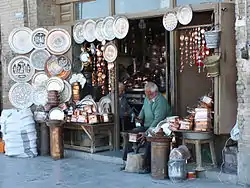




The city centre consists of an older section revolving around the Jameh Mosque, and the Safavid expansion around Naqsh-e Jahan Square, with nearby places of worship, palaces, and bazaars.[95]
Cemeteries
Bagh-e Rezvan Cemetery is one of the biggest and advanced in the country.[96] Other cemetries include New Julfa Armenian Cemetery & Takht-e Foulad.
Bazaars
Bazaar of Isfahan & Qeysarie Gate was built in– 17th century.Social hubs were opium houses & coffeehouses clustered around Chahar bagh & Chehel sotun the best-known traditional coffeehouse is qahva-ḵāna-ye Golestān[97][98][99][100][101][102] There is also Bazar Honar.
Bridges
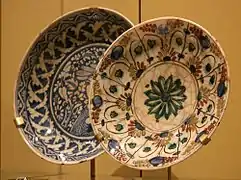
The bridges on the Zayanderud river comprise some of the finest architecture in Isfahan. The oldest bridge is the Shahrestan bridge, whose foundations were built by the Sasanian Empire (3rd–7th century Sassanid era); it was repaired during the Seljuk period. Further upstream is the Khaju bridge, which was built by Shah Abbas II in 1650. It is 123 metres (404 feet) long with 24 arches, and also serves as a sluice gate.
Another bridge is the Choobi (Joui) bridge, which was originally an aqueduct to supply the palace gardens on the north bank of the river. Further upstream again is the Si-o-Seh Pol or bridge of 33 arches. The building was built during the reign of Shah Abbas the Great by Sheikh Baha'i and connected Isfahan with the Armenian suburbs of New Jolfa. Armenian suburb of New Julfa. It is by far the longest bridge in Isfahan at 295 m (967.85 ft).
Another notable bridge is the Marnan Bridge.
Churches and cathedrals
Churches in the city are mostly in the New Julfa region. Some of the historically important ones are Bedkhem Church – 1627, St. Georg Church – 17th century, St. Mary Church – 17th century, Vank Cathedral – 1664. The oldest one is St. Jakob Church – 1607.
Emamzadehs
Gardens and parks
The Pardis Honar Park cost 30 billion toman in District 6 by 2018.[103] Some other zoological gardens and parks (including public & private beach parks, non beach parks) are Birds Garden, Flower Garden of Isfahan, Nazhvan Recreational Complex, Moshtagh, Shahre royaha amusement park, and the East Park of Isfahan. [104]
Houses
Mausoleums and tombs
- Al-Rashid Mausoleum – 12th century
- Baba Ghassem Mausoleum – 14th century
- Mausoleum of Safavid Princes
- Nizam al-Mulk Tomb – 11th century
- Saeb Mausoleum
- Shahshahan mausoleum – 15th century
- Soltan Bakht Agha Mausoleum – 14th century
Minarets
Menar Jonban was built in the 14th century. The tomb is an Iwan measuring 10 meters high.[105] Other menars include Ali minaret – 11th century, Bagh-e-Ghoushkhane minaret – 14th century , Chehel Dokhtaran minaret – 12 century, Dardasht minarets – 14th century, Darozziafe minarets – 14th century, and Sarban minaret.
Mosques
- Agha Nour mosque – 16th century
- Hakim Mosque
- Ilchi mosque
- Jameh Mosque[106]
- Jarchi mosque – 1610
- Lonban mosque
- Maghsoudbeyk mosque – 1601
- Mohammad Jafar Abadei mosque – 1878
- Rahim Khan mosque – 19th century
- Roknolmolk mosque
- Seyyed mosque – 19th century
- Shah Mosque – 1629
- Sheikh Lotf Allah Mosque – 1618
Museums
Schools (madresse)
- Chahar Bagh School – early 17th century
- Harati
- Kassegaran school – 1694
- Madreseye Khajoo
- Nimavar school – 1691
- Sadr school – 19th century
Palaces and caravanserais
- Ali Qapu (The Royal Palace) – early 17th century
- Chehel Sotoun (The Palace of Forty Columns) – 1647
- Hasht-Behesht (The Palace of Eight Paradises) – 1669
- Shah Caravanserai
- Talar Ashraf (The Palace of Ashraf) – 1650
Squares and streets
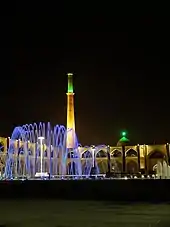
- Chaharbagh Boulevard – 1596
- Chaharbagh-e-khajou Boulevard
- Meydan Kohne (Old Square)
- Naqsh-e Jahan Square also known as "Shah Square" or "Imam Square" – 1602
- Amadegah[107][108]
- Taleghani street (Shah street)[109]
Synagogues
- Kenisa-ye Bozorg (Mirakhor's kenisa)
- Kenisa-ye Molla Rabbi
- Kenisa-ye Sang-bast
- Mullah Jacob Synagogue
- Mullah Neissan Synagogue
- Kenisa-ye Keter David
Other sites
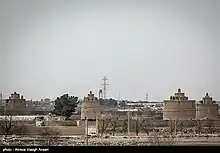
- Atashgah – a Zoroastrian fire temple
- New Julfa – 1606
- Pigeon Towers that are placed all around the city namely 22 towers inside Gavart, Hase [110][111][112][113][114][115] – 17th century
- Isfahan Observatory
- Asarkhane Shahi
Economy
In 2014, Isfahan province industry, mines and commerce accounted for %35 to %50(almost $229 billion) of Iranian Gross Domestic Product.[125][126] Isfahan province governorate in 2019 said tourism is number one priority.[127] َAccording to Esfahan province Administrator for Department of Cooperatives, Labour, and Social Welfare , Iran has cheapest labor workforce anywhere in the world and this low wage attracts foreign investors. Unemployment rate was %15 by 2018.[128] Isfahan University of Technology is one of the most prestigious engineering universities in Iran and focuses on science, engineering and agriculture programs.[129] The labor force shows a continuous growth in the last three decades.[130][131] There are almost 500,000 people living in slums including northern part and specially eastern sector of the city.[132] Isfahan Fair, a 22 hectare exhibition center aimed at increasing tourism, is under construction.Esfahan Province Electricity Distribution Company built in 1992 maintains powergrid expansion in the city.[133][134] As of September 2020 handicrafts of Isfahan Province makes annual $500 million dollars.[135]
Aquaculture and agriculture
Isfahan city is one of the active cities in this field with the production of 1,300 tons of salmon. More than 28% of the country's ornamental fish is produced in Isfahan province and 780 units are active in the field of ornamental fish production, which in 2017 produced 65 million and 500 thousand pieces of ornamental fish in Isfahan province.[136]
Opium was produced and exported in Isfahan from 1850 until it became illegal and was an important source of income.[137] Isfahan has a large number of aqueducts, Farmers had to divert water from the river to farms by canal.[138] Niasarm is one of the biggest water canals.[139] From 2012-2013 there have been large protests against Isfahan-Yazd water tunnel by farmers.[140] Fruits and vegetables central market is where farmers sell their product wholesale buying 10,000 tons farmers product a day.[141]
High tech and heavy industries
The industrialization of Isfahan dates from the Pahlavi period as in all of Iran, and was marked by the strong growth at that time of the textile industry; which earned the city the nickname “ Manchester of Persia”.[142][143] There are 9200 industrial units in the city %40 of Iranian textile industry is in Isfahan.[144]
Telecommunication Company of Iran and Mobile Telecommunication Company of Iran provide 4G, 3G, Broadband and VDSL.[145][146]
Isfahan Scientific and Research Town started its executive activity in 2001 for acting as a medium between government, industry and academia toward a knowledge-based economy.[147]
It is also the third largest medicine manufacturing hub in Iran.[148]
Education and science
Before schools there were maktabkhanehs in the city.[149][150][151][152] In 2019 there were 20 special schools with 5000 children in the city.[153]

Isfahan University of Medical Sciences was established in 1947 and has almost 9200 students & interns, the university campus is adjacent to the University of Isfahan.[154]Isfahan University of Art was established 1977 closed after 1979 revolution and reopened in 1984 after Iranian Cultural Revolution.[155]Isfahan University of Technology started in 1974 buildings are based on Massachusetts Institute of Technology the first university of technology in Iran.[156] Aside from the seminaries and religious schools, the other public, private major universities of the Esfahan metropolitan include: Mohajer Technical And Vocational College of Isfahan, Payame Noor University, Islamic Azad University of Isfahan, Islamic Azad University of Najafabad & Islamic Azad University of Majlesi. There are more than 7329 schools in the Isfahan province.[157]
- High schools
- Mofateh High School
- Farzanegan e Amin High School
- Harati High School
- Imam Mohammad Bagher Education Complex
- Imam Sadegh Education Complex
- Mahboobeh Danesh (Navaie)
- Pooya High School
- Saadi High School
- Sa'eb Education Complex
- Salamat High School
- Saremiyh High School
- Shahid Ejei High School
- Saeb High School
There are also more than 50 technical and vocational training centres in the province under the administration of Esfahan TVTO, which provide free, non-formal training programs.[158] As of 2020 %90 of workforce skills trainees are women.[159]
Transportation
Isfahan post general department built in 1987 is in Neshat street.As of 2020 it was the second biggest after capital Tehran's post office & handles almost 60000 packages a day.[160][161][162][163]
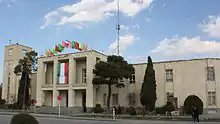
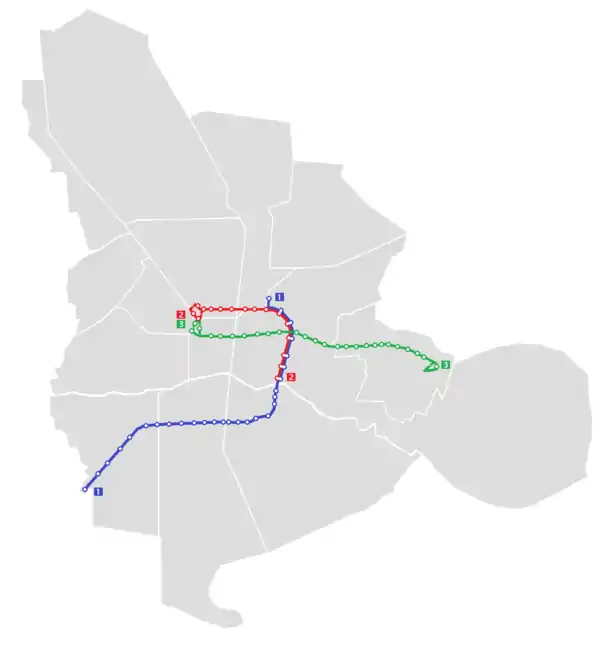

Municipality has signed a memorandum with Khatam-ol-Anbia Base to build Tram.[164]
Ride sharing
Snapp! and Tapsi[165][166] are two of the carpooling apps in the city.[167][168] There are 42 bicycle sharing stations and 150 kilometers bicycle pavements built by city,[169][170] Women are not allowed according to decree by Representative of the Supreme Leader in Isfahan Ayatollah Yousef Tabatabai Nejad and General Attorney Ali Esfahani.[171][172][173][174][175] Shared bicycles were reintroduced to the city again in 2020 with the condition that women won't be allowed, men can use their national ID for getting a bicycle[176]
Customs administration
Control of transfer of freight cargoes to the city are under Isfahan Customs Administration domain.[177][178][179]
Airports
Isfahan International Airport is the only commercial airport.[54]
Roads and freeways
Over the past decade, Isfahan's internal highway network has been undergoing major expansion. Much care has been taken to prevent damage to valuable, historical buildings. Modern freeways connect the city to the country's major cities, including the capital Tehran (length approximately 400 km) to the north and Shiraz (200 km) to the south. Highways also service satellite cities surrounding the metropolitan area.[180] Isfahan Eastern Bypass Freeway is under construction.
Public transit
Isfahan and Suburbs Bus Company runs transit buses in the city.East-West BRT Bus Rapid Transit line buses carry 120,000 on peak day.[181]
Subway
A line of metro that runs for 11 km from north to south opened on 15 October 2015. Two more lines are in construction, alongside three suburban rail lines.[182]
Inter-city rail
China financed Tehran–Qom–Isfahan High Speed Rail.[183]
Bridges
Ghadir Bridge, Vahid Bridge, Ferdosi Bridge, Felezi Bridge, Azar Bridge.Until 2015 Isfahan-Tehran grade separation flyover bridge has cost 120 billion toman.[184]
.jpg.webp)
Notable people
- Music
- Jalal Taj Esfahani (1903–1981)[185]
- Alireza Eftekhari (1956–), singer[186]
- Fard
- Leila Forouhar (1959–), pop singer[187]
- Hassan Kassai (1928–2012), musician[188]
- Hassan Shamaizadeh, songwriter and singer[189]
- Jalil Shahnaz (1921–2013), tar soloist, a traditional Persian instrument[190]
- Film
- Rasul Sadr Ameli (1953–), director
- Sara Bahrami (1983–), actor[191]
- Homayoun Ershadi (1947–), Hollywood actor and architect
- Soraya Esfandiary-Bakhtiari (1956–2001), former princess of Iran and actress
- Bahman Farmanara (1942–), director
- Jahangir Forouhar (1916–1997), actor and father of Leila Forouhar (Iranian singer)
- Mohamad Ali Keshvarz (1930–2020), actor[192]
- Mahdi Pakdel (1980–), actor[193]
- Nosratollah Vahdat (1925–2020), actor[194]
- Craftsmen and painters
- Mahmoud Farshchian (1930–), painter and miniaturist[195]
- Bogdan Saltanov (1630s–1703), Russian icon painter of Isfahanian Armenian origin
- Political figures
- Ahmad Amir-Ahmadi (1906–1965), military leader and cabinet minister
- Ayatollah Mohammad Beheshti (1928–1981), cleric, Chairman of the Council of Revolution of Iran[196]
- Nusrat Bhutto, Chairman of Pakistan Peoples Party from 1979–1983; wife of Zulfikar Ali Bhutto; mother of Benazir Bhutto
- Hossein Fatemi, PhD (1919–1954), politician; foreign minister in Mohamed Mossadegh's cabinet
- Mohammad-Ali Foroughi (1875–1942), a politician and Prime Minister of Iran in the World War II era[197]
- Dariush Forouhar (August 1928 – November 1998), a founder and leader of the Hezb-e Mellat-e Iran (Nation of Iran Party)
- Hossein Kharrazi, chief of the army in the Iran–Iraq War[198]
- Mohsen Nourbakhsh (1948–2003), economist, Governor of the Central Bank of Iran
- Mohammad Javad Zarif (1960–), Minister of Foreign Affairs and former Ambassador of Iran to the United Nations[199]
- Religious figures
- Lady Amin (Banou Amin) (1886–1983), Iran's most outstanding female jurisprudent, theologian and great Muslim mystic (‘arif), a Lady Mujtahideh
- Amina Begum Bint al-Majlisi was a female Safavid mujtahideh
- Ayatollah Mohammad Beheshti (1928–1981), cleric, Chairman of the Council of Revolution of Iran[196]
- Allamah al-Majlisi (1616–1698), Safavid cleric, Sheikh ul-Islam in Isfahan
- Salman the Persian
- Muhammad Ibn Manda (d. 1005 / AH 395), Sunni Hanbali scholar of hadith and historian
- Abu Nu'aym Al-Ahbahani Al-Shafi'i (d. 1038 / AH 430), Sunni Shafi'i Scholar
- Seyyed Ali Qazi Askar (1954) Iran's supreme leader representative, in Haj
- Sportspeople
- Abdolali Changiz, football star of Esteghlal FC in the 1970s
- Mansour Ebrahimzadeh, former player for Sepahan FC, former head coach of Zobahan
- Ghasem Haddadifar, captain of Zobahan FC
- Arsalan Kazemi, forward for the Oregon Ducks men's basketball team and the Iran national basketball team
- Rasoul Korbekandi, goalkeeper of the Iranian National Team
- Moharram Navidkia, captain of Sepahan FC
- Mohammad Talaei, world champion wrestler
- Mahmoud Yavari (1939-), football player, coach of Iranian National Team
- Sohrab Moradi (1988-), Olympic weightlifting gold medalist, world record holder of 105 kg category
- Milad Beigi (1991-) Olympic taekwando bronze medalist, world champion
- Sina Karimian, k-1 cruiserweight kickboxing champion
- Writers and poets
- Mohammad-Ali Jamālzādeh Esfahani (1892–1997), author
- Hatef Esfehani, Persian Moral poet in the Afsharid Era
- Kamal ed-Din Esmail (late 12th century - early 13th century)
- Houshang Golshiri (1938–2000), writer and editor
- Hamid Mosadegh (1939–1998), poet and lawyer
- Mirza Abbas Khan Sheida (1880–1949), poet and publisher
- Saib Tabrizi
- Others
- Ispahani family, Perso-Bangladeshi business family
- Abd-ol-Ghaffar Amilakhori, 17th-century noble
- Adib Boroumand (1924-), poet, politician, lawyer, and leader of the National Front
- George Bournoutian, professor, historian and author
- Jesse of Kakheti, king of Kakheti in eastern Georgia from 1614 to 1615
- Simon II of Kartli, king of Kartli in eastern Georgia from 1619 to 1630/1631
- David II of Kakheti, king of Kakheti in eastern Georgia from 1709 to 1722
- Constantine II of Kakheti, king of Kakheti in eastern Georgia from 1722 to 1732
- Nasser David Khalili (1945–), property developer, art collector, and philanthropist
- Arthur Pope (1881–1969), American archaeologist, buried near Khaju Bridge
- Alexandre de Rhodes (1591–1660), French Jesuit, designer of Vietnamese alphabet, buried in the city's Armenian cemetery

Recreation and tourism
Gaz (candy) & Poolaki are two souvenirs.
In 2019-2018 some 450,000 foreign nationals visited the city.Some 110 trillion rials (over $2 billion at the official rate of 42,000 rials(2020) have been invested in the province’s tourism sector.[200]
The central historical area in Isfahan is called Seeosepol.[201]
Isfahan is noted for its production of the Isfahan rug, a type of Persian rug typically made of merino wool and silk.
Teahouses are supervised and allowed to offer Hookah until 2022.[202] As of 2020 there are almost 300 teahouses with permit.[203]
Nazhvan Park hosts a reptile zoo with 40 aquariums.[204] Saadi water park, Nazhvan kids water park[205]
Ancient baths include Jarchi hammam & The Bathhouse of Bahāʾ al-dīn al-ʿĀmilī; a public bath called “Garmabeh-e-shaykh” in Isfahan which for a long period it was running and providing hot water to public for years without any visible heating system of the day which usually needed tons of wood was built by Baha' al-din al-'Amili.[206][207][208][209]Khosro Agha hammam was demolished by unknown people in 1992.Ali Gholi Agha hammam is another remaining one.. Chardin writes that the number of baths in Isfahan in the Safavid era is 273.[98]
There is a lot of luxury party gardens & wedding halls.[210][211][212]
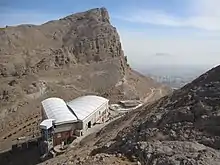
Medical tourism
Isfahan Healthcare city complex, built on a 300 hectare site near the Aqa Babaei Expressway, is intended to boost the city's medical tourism revenues.[213]
Shopping
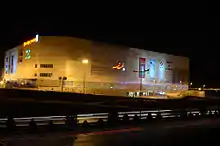
Hypermarkets
Refah Chain Stores Co., Iran Hyper Star, Isfahan city center, Shahrvand Chain Stores Inc.,Park commercial complex[214] & Isfahan Mall.
Cinemas
There are 9 cinemas.[215] Historically cinemas in old Isfahan were entertainment for worker class while the religious people considered cinema to be mostly an impure place and going to the cinema to be haram. Because of 1979 revolution many cinemas in Isfahan were burned down. Great filmmakers such as Agnès Varda and Pier Paolo Pasolini shot scenes from their films in Isfahan. Cinema Iran now a ruin was one of the oldest cinemas in the city.[216][217][218]
Sports
Isfahan has three association football clubs that play professionally. These are:
Sepahan has won the most league titles among the Iranian clubs (2002–03, 2009–10, 2010–11, 2011–12 and 2014–15).[219]
Giti Pasand also has a futsal team, Giti Pasand FSC, one of the best teams in Asia. They won the AFC Futsal Club Championship in 2012 and were runners-up in 2013. Basketball clubs include Zob Ahan Isfahan BC, Foolad Mahan Isfahan BC[220] There is also women's volleyball team Giti Pasand Isfahan VC that plays matches in Iranian Women's Volleyball League.[221] There are Pahlavani zoorkhanehs in the city.[222][223] Foolad Mobarakeh Sepahan (handball) team is one of the teams in Iranian handball league. Sepahan has a youth women runners that became national champion in 2020.[224]
Civic administration

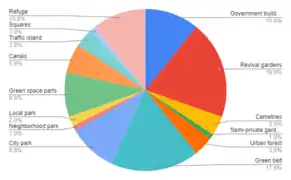
Government
The chairman of the city council is Alireza Nasrisfahani,[225] and the mayor is Ghodratollah Noroozi.[226] Representative for supreme leader and representative for Isfahan in Assembly of Experts is Yousef Tabatabai Nejad.[227] The city's divided into 15 municipal districts.
| Municipal districts of Isfahan | |||||||||||||||||||||||||||||||||||||||||||||||||||||||||||||||||||||||||||||||||||||||||||||||||||||||||||||||||||||||
|---|---|---|---|---|---|---|---|---|---|---|---|---|---|---|---|---|---|---|---|---|---|---|---|---|---|---|---|---|---|---|---|---|---|---|---|---|---|---|---|---|---|---|---|---|---|---|---|---|---|---|---|---|---|---|---|---|---|---|---|---|---|---|---|---|---|---|---|---|---|---|---|---|---|---|---|---|---|---|---|---|---|---|---|---|---|---|---|---|---|---|---|---|---|---|---|---|---|---|---|---|---|---|---|---|---|---|---|---|---|---|---|---|---|---|---|---|---|---|---|
|
Small towns
- Shahrak-e Zayandeh Rud , District 4 Pinart[228][229]
Leadership Council
In the new mechanism for preparing and approving the comprehensive plan of the city, there is an institution called the Isfahan city leadership council under the Islamic City Council of Isfahan domain.Member organizations are
- Isfahan Guilds Chamber
- Isfahan Chamber of Commerce, Industries, Mines and Agriculture
- Department of Roads and Urban Development
- Department of Economic Affairs and Finance
- Department of Environmental Protection
- Isfahan Governorate
- Management and Planning Organization
- Isfahan Farmers' House
- Isfahan Workers' House
- Agricultural Jihad Organization
- NGOs
Public works
Coloring theme for the city has been Turquoise for a period of time.[231]
Waste disposal
City waste is processed and recycled in Isfahan Waste Complex.[232]
Water & wastewater treatment
Esfahan water & wastewater Organization is responsible for piping operation, network installation, preventive maintenance, repairing waterworks, wastewater equipment, supervising wastewater collection and treatment and disposal in the city.[233][234]
Future city
Municipality created a document in 2020 outlining future development program for the city.[235]
Political parties
Main parties are Reformists(including Islamic Iran Freedom and Justice Organization) and Islamic revolution principalists forces.[236]
Human resources and public health/safety
In 2020, Municipality employed 6250 people with additional 3000 people in 16 subsidiaries.[237] During Iran-Iraq war 23000 were killed from Isfahan and there are 43000 veterans.[238] As of June 2020, 65% of the population of Isfahan province has had social security insurance .[239] Isfahan is known as the capital of the world Multiple sclerosis disease due to the presence of polluting industries.[240] In 2015, with the cut-off of the Zayandehrood River, almost 15% of people suffered from depression.[241]
- List of Isfahan hospitals
- Courts of Isfahan
Foreign affairs
Consulates and embassies
Russian Federation General Consulate in Isfahan is registered cultural heritage.[242] Chinese have expressed readiness to be the first country that opens consulate in a diplomatic zone in the central city[243] The residence of Afghan nationals is allowed in Esfahan city.There is a plan in the future to create a diplomatic district next to Imam Khamenei international convention center for countries to base their consulates offices in.[164]
Twin towns – sister cities
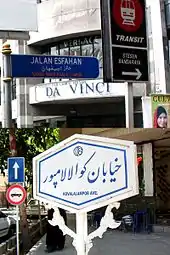
 Baalbek, Lebanon (2010)
Baalbek, Lebanon (2010)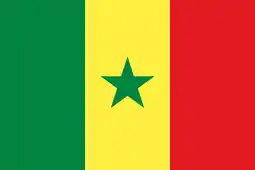 Dakar, Senegal (2009)
Dakar, Senegal (2009) Florence, Italy (1998)
Florence, Italy (1998) Freiburg im Breisgau, Germany (2000)
Freiburg im Breisgau, Germany (2000) Havana, Cuba (2001)
Havana, Cuba (2001) Iași, Romania (1999)
Iași, Romania (1999) Kuala Lumpur, Malaysia (1997)
Kuala Lumpur, Malaysia (1997)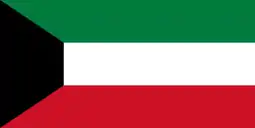 Kuwait City, Kuwait (2000)
Kuwait City, Kuwait (2000)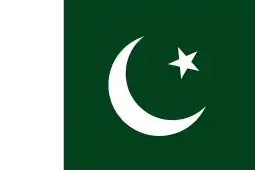 Lahore, Pakistan (2004)
Lahore, Pakistan (2004) Saint Petersburg, Russia (2004)
Saint Petersburg, Russia (2004) Yerevan, Armenia (2000)
Yerevan, Armenia (2000) Xi'an, Shaanxi, China (1989)
Xi'an, Shaanxi, China (1989)
References
- http://www.daftlogic.com/downloads/kml/10102015-9mzrdauu.kml%5B%5D
- "Statistical Center of Iran > Home". Archived from the original on 8 July 2018. Retrieved 27 September 2018.
- "Major Agglomerations of the World - Population Statistics and Maps". citypopulation.de. 13 September 2018. Archived from the original on 13 September 2018.
- "Isfahan Climate - IRAN TRAVEL, TRIP TO IRAN". www.irangazette.com. Archived from the original on 24 February 2020. Retrieved 24 February 2020.
- "Population of Cities in Iran (2018)." The population of the greater metropolitan area is 5.1 million (2016 Census).
- "Isfahan Is Half The World". New York Times. Archived from the original on 23 July 2018. Retrieved 23 July 2018.
- "Isfahan, Pre-Islamic-Period". Encyclopædia Iranica. 15 December 2006. Archived from the original on 17 November 2015. Retrieved 31 December 2015.
- Strazny, P. (2005). Encyclopedia of linguistics (p. 325). New York: Fitzroy Dearborn.
- "وجه تسمیه اصفهان". daneshnameh.roshd.ir. Archived from the original on 25 February 2020. Retrieved 6 October 2020.
- "::: سازمان تبلیغات اسلامی استان اصفهان :::". 8 May 2008. Archived from the original on 8 May 2008. Retrieved 6 October 2020.
- "Iran: Provinces and Cities population statistics". Archived from the original on 25 January 2020. Retrieved 13 February 2020.
- Gharipour Mohammad (14 November 2014). Sacred Precincts: The Religious Architecture of Non-Muslim Communities Across the Islamic World. Brill. p. 179.
- "Ishafan". ArchNet. Archived from the original on 23 October 2013. Retrieved 15 July 2013.
- Salma, K. Jayyusi; Holod, Renata; Petruccioli, Attilio; André, Raymond (2008). The City in the Islamic World. Leiden: Brill. p. 174. ISBN 9789004162402.
- Huff, D. "ARCHITECTURE iii. Sasanian Period – Encyclopaedia Iranica". www.iranicaonline.org. Encyclopaedia Iranica. Archived from the original on 29 March 2019. Retrieved 16 March 2019.
- "City Walls of Isfahan". Archnet. Retrieved 3 November 2020.
- Golombek, Lisa (1974). "Urban Patterns in Pre-Safavid Isfahan". Iranian Studies. 7 (1/2): 18–44. doi:10.1080/00210867408701454. ISSN 0021-0862. JSTOR 4310152.
- Isstaif, Abdul-Nabi (1997). "Review of Al-Muqaddasī: The Best Divisions for Knowledge of the Regions: Aḥsan al-Taqāsīm fī Ma'rifat al-Aqālīm". Journal of Islamic Studies. 8 (2): 247–250. doi:10.1093/jis/8.2.247. ISSN 0955-2340. JSTOR 26198094. Archived from the original on 6 November 2020. Retrieved 3 November 2020.
- "Britannica.com". Archived from the original on 23 July 2018. Retrieved 23 July 2018.
- Battutah, Ibn (2002). The Travels of Ibn Battutah. London: Picador. p. 68. ISBN 9780330418799.
- Fisher, W.B.; Jackson, P.; Lockhart, L.; Boyle, J.A. : The Cambridge History of Iran, p. 55.
- electricpulp.com. "ISFAHAN vii. SAFAVID PERIOD – Encyclopaedia Iranica". Archived from the original on 17 May 2018. Retrieved 19 June 2015.
- Matthee 2012, p. 67.
- Aslanian, Sebouh (2011). From the Indian Ocean to the Mediterranean: The Global Trade Networks of Armenian Merchants from New Julfa. California: University of California Press. p. 1. ISBN 978-0520947573.
- Bournoutian, George (2002). A Concise History of the Armenian People: (from Ancient Times to the Present) (2 ed.). Mazda Publishers. p. 208. ISBN 978-1568591414.
- Iran Almanac and Book of Facts. 8. Echo Institute. 1969. p. 71. OCLC 760026638. Archived from the original on 11 February 2020. Retrieved 25 January 2018.
- "Esfahan / Isfahan - Iran Special Weapons Facilities". fas.org. Archived from the original on 29 September 2020. Retrieved 9 November 2020.
- "MSC at a Glance". Archived from the original on 17 August 2017. Retrieved 19 July 2017.
- "Esfahan Steel Company A Pioneer in The Steel Industry of Iran". Archived from the original on 29 November 2018. Retrieved 19 July 2017.
- Hesaco.com Archived 9 June 2007 at the Wayback Machine (from the HESA official company website)
- Pike, John. "HESA Iran Aircraft Manufacturing Industrial Company". Archived from the original on 16 October 2014. Retrieved 23 September 2014.
- "International conference held on investment opportunities in Iran tourism industry". Archived from the original on 25 September 2014. Retrieved 23 September 2014.
- "Iran, Qatar Move to Broaden Economic Ties - Economy news". Tasnim News Agency. Archived from the original on 25 November 2020. Retrieved 18 December 2020.
- "MONITORING THE DEVASTATION OF ISFAHAN ARTIFICIAL WATER CHANNELS USING REMOTE SENSING AND GIS" (PDF). The International Symposium on Spatio-Temporal Modeling ,2005. Archived (PDF) from the original on 30 October 2020. Retrieved 29 October 2020.
|first=missing|last=(help) - "حفر و تجهیز 70 حلقه چاه جدید برای جبران کمبود آب آشامیدنی اصفهان". kayhan.ir. Archived from the original on 15 December 2020. Retrieved 15 December 2020.
- "اصفهان| خشکسالی پیدرپی در اصفهان چاههای فلمن را هم خشک کرد- اخبار استانها تسنیم - Tasnim". خبرگزاری تسنیم - Tasnim (in Persian). Archived from the original on 15 December 2020. Retrieved 15 December 2020.
- "Isfahan's Organic and Planned Form of Urban. Greenways in Safavid Period" (PDF). www.sid.ir. Archived (PDF) from the original on 15 December 2020. Retrieved 15 December 2020.
- Nader, Nik Kowsar, Alireza. "Iran Is Committing Suicide by Dehydration". Foreign Policy. Archived from the original on 19 August 2020. Retrieved 23 September 2020.
- "Workers demand months of unpaid wages in 9 Iran protests". Iran News Wire. Archived from the original on 24 September 2020. Retrieved 23 September 2020.
- Maxwell, Mary Jane (3 August 2018). "Iran arrests scientists trying to solve water crisis". ShareAmerica. Archived from the original on 29 August 2020. Retrieved 23 September 2020.
- Dehghanpisheh, Babak (29 March 2018). "Water crisis spurs protests in Iran". Reuters. Archived from the original on 14 September 2020. Retrieved 23 September 2020.
- "اعتراضات جدید کشاورزان اصفهان به معضل کمآبی و حقآبه | صدای آمریکا فارسی". ir.voanews.com (in Persian). Archived from the original on 24 September 2020. Retrieved 23 September 2020.
- "Archived copy". www.iribnews.ir. Archived from the original on 30 October 2020. Retrieved 28 October 2020.CS1 maint: archived copy as title (link)
- "هیچ کلانشهری در ایران به اندازه اصفهان آلوده نیست". Archived from the original on 27 January 2021. Retrieved 18 January 2021.
- "Archived copy". Archived from the original on 27 January 2021. Retrieved 18 January 2021.CS1 maint: archived copy as title (link)
- "کلاف سردرگم آلودگی هوای اصفهان و مقصرانی که زیربار نمیروند / منشأ آلودگی هوا کجاست؟ + فیلم". Archived from the original on 27 January 2021. Retrieved 18 January 2021.
- "اینجا هوا کم است". Archived from the original on 27 January 2021. Retrieved 18 January 2021.
- "Archived copy". Archived from the original on 22 October 2020. Retrieved 19 October 2020.CS1 maint: archived copy as title (link)
- "پرندهای با دمجنبان! | روزنامه اصفهان زیبا". 7 August 2019. Archived from the original on 7 August 2019. Retrieved 6 October 2020.
- "Archived copy". Archived from the original on 30 October 2020. Retrieved 29 October 2020.CS1 maint: archived copy as title (link)
- "BIOLOGICAL CONTROL OF INSECT PARASITIC NEMATODES USING GRASS" (PDF). New Ideas in Agriculture. Archived (PDF) from the original on 30 October 2020. Retrieved 29 October 2020.
- "1 - IRAN TRAVEL, TRIP TO IRAN". www.irangazette.com. Archived from the original on 16 March 2018. Retrieved 10 November 2020.
- "Archived copy". Archived from the original on 19 October 2020. Retrieved 19 October 2020.CS1 maint: archived copy as title (link)
- "اصفهان - تاريخچه". isfahan.airport.ir. Archived from the original on 3 August 2020. Retrieved 22 September 2020.
- "بارورسازی ابرها در 10 استان کشور با پهپاد- اخبار اقتصادی تسنیم - Tasnim". خبرگزاری تسنیم - Tasnim (in Persian). Archived from the original on 7 January 2020. Retrieved 21 September 2020.
- https://web.archive.org/web/20200909114804/https://donya-e-eqtesad.com/%D8%A8%D8%AE%D8%B4-%D8%B3%D8%A7%DB%8C%D8%AA-%D8%AE%D9%88%D8%A7%D9%86-62/3689253-%D8%A7%DB%8C%D9%86-%D9%85%D9%88%D8%B4%DA%A9-%D9%82%D8%AF%D8%B1%D8%AA%D9%85%D9%86%D8%AF-%D8%A7%DB%8C%D8%B1%D8%A7%D9%86%DB%8C-%D8%A2%D9%85%D8%B1%DB%8C%DA%A9%D8%A7%DB%8C%DB%8C-%D9%87%D8%A7-%D8%B1%D8%A7-%D8%A8%D9%87-%D9%88%D8%AD%D8%B4%D8%AA-%D8%A7%D9%86%D8%AF%D8%A7%D8%AE%D8%AA-%D9%85%D8%B4%D8%AE%D8%B5%D8%A7%D8%AA-%D8%B9%DA%A9%D8%B3
- Boring, War Is (12 June 2019). "The First Time the F-14 Tomcat Killed in Battle (But Not for America)". The National Interest. Archived from the original on 13 June 2019. Retrieved 22 September 2020.
- Leone, Dario (8 July 2019). "Whoops: During the Iran-Iraq War, Baghdad Shot down an Iranian F-14A That Was Trying to Defect". The National Interest. Archived from the original on 23 September 2020. Retrieved 22 September 2020.
- انتصاب فرمانده پایگاه هشتم شکاری شهید بابایی اصفهان. www.iribnews.ir. Archived from the original on 16 May 2019. Retrieved 22 September 2020.
- "Archived copy". Archived from the original on 30 October 2020. Retrieved 26 October 2020.CS1 maint: archived copy as title (link)
- مراسم معارفه فرمانده سپاه صاحب الزمان (عج) استان اصفهان به روایت تصاویر- اخبار اصفهان - اخبار استانها تسنیم - Tasnim. 9 September 2020. Archived from the original on 9 September 2020.
- فرمانده سپاه اصفهان: نظام از امتحان کرونا موفق بیرون آمده است - ایرنا. 14 June 2020. Archived from the original on 14 June 2020.
- "Isfahan, Iran - Detailed climate information and monthly weather forecast". Weather Atlas. Yu Media Group. Archived from the original on 5 February 2020. Retrieved 5 February 2020.
- "کاشت درخت زیتون در اصفهان صرفه اقتصادی دارد". ایمنا (in Persian). 4 October 2018. Archived from the original on 10 February 2019. Retrieved 27 October 2020.
- "Esfahan Climate Normals 1961-1990". National Oceanic and Atmospheric Administration. Archived from the original on 22 September 2020. Retrieved 8 April 2015.
- "Highest record temperature in Esfahan by Month 1951–2010". Iran Meteorological Organization. Archived from the original on 25 October 2016. Retrieved 8 April 2015.
- "Lowest record temperature in Esfahan by Month 1951–2010". Iran Meteorological Organization. Archived from the original on 4 March 2016. Retrieved 8 April 2015.
- "جوانان اصفهانی در هفتخان ازدواج". Archived from the original on 6 August 2019. Retrieved 18 January 2021.
- "سنازدواج در کدام شهرها بالاتر است؟". Archived from the original on 27 January 2021. Retrieved 18 January 2021.
- https://dw.com/fa-ir/%D8%B3%D9%88%D9%85%DB%8C%D9%86-%D8%AF%D9%88%D8%B1%D9%87-%D8%AC%D8%A7%DB%8C%D8%B2%D9%87-%D8%A7%D8%AF%D8%A8%DB%8C-%D8%A7%D8%B5%D9%81%D9%87%D8%A7%D9%86/a-2407342
- https://www.irna.ir/news/83537012/
- "Archived copy". Archived from the original on 5 October 2020. Retrieved 4 October 2020.CS1 maint: archived copy as title (link)
- "Archived copy". Archived from the original on 5 October 2020. Retrieved 4 October 2020.CS1 maint: archived copy as title (link)
- "اضافه شدن ۱۱ اثر هنری به مجسمههای شهر اصفهان | درگاه الكترونيكي شهرداري اصفهان". Archived from the original on 11 September 2020.
- "آداب و رسوم مردم اصفهان". www.beytoote.com. Archived from the original on 5 August 2020. Retrieved 10 December 2020.
- "بهنام". www.ichodoc.ir. Archived from the original on 18 January 2018. Retrieved 10 December 2020.
- "آشنایی با مکتب اصفهان". همشهری آنلاین (in Persian). 12 July 2011. Archived from the original on 30 January 2019. Retrieved 18 December 2020.
- تبیان, موسسه فرهنگی و اطلاع رسانی. "مکتب اصفهان". article.tebyan.net (in Persian). Archived from the original on 17 April 2017. Retrieved 18 December 2020.
- Reza, Khajeh Ahmad Attari Ali; Habibollah, Ayatollahi; Asghar, Shirazi Ali; Mohsen, Marasi; Khashayar, Ghazizadeh (20122013/01/01). "THE STUDY OF HUMAN ICONOGRAPHY IN THE PAINTING SCHOOL OF ISFAHAN 10-11/16-17". 2 (4): 81–92. Archived from the original on 18 December 2020. Retrieved 18 December 2020. Cite journal requires
|journal=(help); Check date values in:|date=(help) - "از جشنوارۀ تئاتر اصفهان چه خبر؟". ایسنا (in Persian). 19 December 2020. Archived from the original on 19 December 2020. Retrieved 19 December 2020.
- "تاریخچه تئاتر اصفهان". پایگاه خبری نمانامه (in Persian). 7 October 2019. Retrieved 19 December 2020.
- "انسان شناسی و فرهنگ | انسانشناسی، علمیترین رشته علوم انسانی و انسانیترین رشته در علوم است". anthropology.ir. Archived from the original on 19 December 2020. Retrieved 19 December 2020.
- "Iranian theaters" (PDF). Esfahan Theater. Archived (PDF) from the original on 19 December 2020. Retrieved 19 December 2020.
- https://www.iranhumanrights.org/2018/01/female-musician-banned-from-performing-on-stage-in-isfahan/#:~:text=Iranian%20singer%20Salar%20Aghili%20performed,Iran%20(CHRI)%20has%20learned Archived 28 October 2020 at the Wayback Machine.
- "اطلس اصفهان". new.isfahan.ir. Archived from the original on 22 September 2020. Retrieved 22 September 2020.
- "رونمايي از اطلس شهر اصفهان". ایمنا (in Persian). 27 August 2015. Archived from the original on 22 September 2020. Retrieved 22 September 2020.
- "اطلس کلانشهر اصفهان را در پورتال شهرداری ببینید". ایمنا (in Persian). 9 December 2017. Archived from the original on 2 February 2019. Retrieved 22 September 2020.
- "صدا و سیمای مرکز اصفهان - صدا و سیمای اصفهان". isfahan.irib.ir. Archived from the original on 9 September 2020. Retrieved 22 September 2020.
- "Archived copy". Archived from the original on 29 April 2020. Retrieved 2 December 2020.CS1 maint: archived copy as title (link)
- "Mir Damad, Muhammad Baqir (d. 1631)". www.muslimphilosophy.com. Archived from the original on 20 February 2020. Retrieved 17 January 2021.
- "MIR FENDERESKI – Encyclopaedia Iranica". iranicaonline.org. Archived from the original on 22 January 2021. Retrieved 17 January 2021.
- Hammarström, Harald; et al. "Spoken L1 Language: Western Farsi". Glottolog. Archived from the original on 19 July 2020. Retrieved 30 September 2020.
- "پژوهشي رَوِشمند درگُستره يي زبان شناختي | Foundation for Iranian Studies". www.fis-iran.org. Archived from the original on 18 August 2017. Retrieved 18 September 2020.
- "ISFAHAN xix. JEWISH DIALECT – Encyclopaedia Iranica". iranicaonline.org. Retrieved 17 December 2020.
- Assari, A., Mahesh, T., Emtehani, M., & Assari, E. (2011). Comparative sustainability of bazaar in Iranian traditional cities: Case studies in Isfahan and Tabriz. International Journal on Technical and Physical Problems of Engineering (IJTPE)(9), 18-24. Archived 22 December 2018 at the Wayback Machine
- "Archived copy". Archived from the original on 14 April 2020. Retrieved 4 October 2020.CS1 maint: archived copy as title (link)
- "بازار اصفهان؛ بازمانده شکوه دوران صفوی". BBC News فارسی (in Persian). Archived from the original on 11 September 2019. Retrieved 5 October 2020.
- "بازار های اصفهان در دوره صفویه". rasekhoon.net. Archived from the original on 6 May 2017. Retrieved 30 October 2020.
- "COFFEEHOUSE – Encyclopaedia Iranica". www.iranicaonline.org. Archived from the original on 26 May 2020. Retrieved 30 October 2020.
- "کوکنارخانهها و قهوهخانههای عصر صفوی". www.cgie.org.ir (in Persian). Archived from the original on 30 October 2020. Retrieved 30 October 2020.
- "shahrvand newspaper opium houses 2017" (PDF). Archived (PDF) from the original on 30 October 2020.
- "Coffee Ruled Before Teahouses Became the Culture". Financial Tribune. 20 December 2014. Archived from the original on 30 October 2020. Retrieved 30 October 2020.
- "پروژه۳۰ میلیارد تومانی پردیس هنر اصفهان افتتاح میشود - ایمنا". 14 October 2020. Archived from the original on 14 October 2020. Retrieved 14 October 2020.
- "پارک ها و مراکز تفریحی استان اصفهان + تصاویر". ندای اصفهان. 18 January 2016. Archived from the original on 26 February 2020. Retrieved 14 October 2020.
- "Wikiwix's cache". archive.wikiwix.com. Archived from the original on 14 October 2020. Retrieved 14 October 2020.
- "Isfahan Jame(Congregative) mosque – BackPack". Fz-az.fotopages.com. Archived from the original on 3 March 2016. Retrieved 26 July 2009.
- "آمادگاه چرا آمادگاه شد؟". اصفهان امروز آنلاین (in Persian). Archived from the original on 11 February 2020. Retrieved 4 January 2021.
- "گذری بر خیابان آمادگاه اصفهان آمادگاه؛ خیابان آه و ناله". ایسنا (in Persian). 16 May 2011. Archived from the original on 4 January 2021. Retrieved 4 January 2021.
- "Archived copy". Archived from the original on 17 July 2020. Retrieved 14 January 2021.CS1 maint: archived copy as title (link)
- 3049 (7 April 2020). "کبوترخانههای گورت اصفهان و وعدههایی که عملی نشد". ایرنا (in Persian). Archived from the original on 17 December 2020. Retrieved 17 December 2020.CS1 maint: numeric names: authors list (link)
- "برج کبوتر حصه جان دوباره میگیرد". ایمنا (in Persian). 24 September 2019. Archived from the original on 17 December 2020. Retrieved 17 December 2020.
- "برج های کبوتر روستای گورت- عکس مستند تسنیم - Tasnim". خبرگزاری تسنیم - Tasnim (in Persian). Retrieved 17 December 2020.
- 2723 (12 January 2020). "صیانت از تاریخ با احیای کبوترخانهها". ایرنا (in Persian). Retrieved 17 December 2020.CS1 maint: numeric names: authors list (link)
- "Archived copy". www.iribnews.ir. Archived from the original on 17 December 2020. Retrieved 17 December 2020.CS1 maint: archived copy as title (link)
- "Castles of the Fields". Saudi Aramco World. Archived from the original on 7 October 2012. Retrieved 11 September 2012.
- "10 Weird Persian Food That Will Blow Your Mind in Iran". Persian Food Tour. 21 October 2019. Archived from the original on 30 April 2020. Retrieved 11 December 2020.
- tradition, Kimia RaghebiBeing exposed to the brilliant Iranian; Monuments, Historical; literature, artistic artifacts throughout my life has always thrilled me Traces of such joyful fascination have become more tangible in me ever since I. chose; traveling, creative writing as my profession So here I. am; experiencing; enjoying; Lens!, Jotting down Every Bit of Them All for You to Sense Its Magical Wonder Through My (25 December 2019). "Iran's Delicious Food Destinations". Visit Our Iran - Discover Iran. Archived from the original on 11 August 2020. Retrieved 11 December 2020.
- "Archived copy". www.parsine.com. Archived from the original on 12 December 2020. Retrieved 12 December 2020.CS1 maint: archived copy as title (link)
- "طرز تهیه آش کدو حلوایی اصفهان با ماش و سبزی، خوشمزه و مجلسی". فیدیا (in Persian). 27 October 2020. Archived from the original on 12 December 2020. Retrieved 12 December 2020.
- "آش کدو اصفهانی". takandam.com. Archived from the original on 12 December 2020. Retrieved 12 December 2020.
- "Archived copy". www.parsine.com. Archived from the original on 11 December 2020. Retrieved 11 December 2020.CS1 maint: archived copy as title (link)
- "Khoresht mast | Traditional Dessert From Isfahan | TasteAtlas". www.tasteatlas.com. Archived from the original on 11 December 2020. Retrieved 11 December 2020.
- "BERYĀNĪ – Encyclopaedia Iranica". iranicaonline.org. Archived from the original on 26 September 2020. Retrieved 11 December 2020.
- Staff, IFP Editorial (13 October 2017). "Beryani; Special Meal of Iran's Isfahan Province". Iran Front Page. Archived from the original on 11 December 2020. Retrieved 11 December 2020.
- "Archived copy". Archived from the original on 16 November 2019. Retrieved 8 October 2020.CS1 maint: archived copy as title (link)
- "Archived copy". Archived from the original on 8 October 2020. Retrieved 8 October 2020.CS1 maint: archived copy as title (link)
- http://www.ostan-es.ir/index.aspx?page_=news&lang=1&tempname=mainshow&sub=0&PageID=67160&PageIDF=4&BlockName=tool_news_sample_maintab_block19%5B%5D
- "دستمزد پایین کارگر در ایران باعث جذب سرمایهگذاران خارجی شده است". ایسنا (in Persian). 8 May 2019. Archived from the original on 5 October 2020. Retrieved 5 October 2020.
- "Isfahan University of Technology | Isfahan University of Technology". www.iut.ac.ir. Archived from the original on 1 February 2020. Retrieved 22 September 2020.
- "Isfahan xiv. MODERN ECONOMY AND INDUSTRIES ( – Encyclopaedia Iranica". iranicaonline.org. Archived from the original on 26 May 2020. Retrieved 18 September 2020.
- "Isfahan xiv. MODERN ECONOMY AND INDUSTRIES ( – Encyclopaedia Iranica". iranicaonline.org. Archived from the original on 26 May 2020. Retrieved 18 September 2020.
- "زنگ خطر آسیب های اجتماعی در مناطق حاشیه نشین نصف جهان". 9 February 2020. Archived from the original on 9 February 2020. Retrieved 22 September 2020.
- "Archived copy". Archived from the original on 26 October 2020. Retrieved 23 October 2020.CS1 maint: archived copy as title (link)
- "Archived copy". Archived from the original on 15 October 2020. Retrieved 15 October 2020.CS1 maint: archived copy as title (link)
- "درآمد سالانه ۵۰۰ میلیون دلاری صنایع دستی استان اصفهان". ایمنا (in Persian). 30 September 2020. Archived from the original on 30 October 2020. Retrieved 28 October 2020.
- "سهم استان اصفهان از تولیدات ماهی کشور در سال گذشته". ایمنا (in Persian). 23 December 2018. Archived from the original on 28 January 2019. Retrieved 23 September 2020.
- "AFYŪN – Encyclopaedia Iranica". 26 May 2020. Archived from the original on 26 May 2020. Retrieved 23 September 2020.
- "مادی های اصفهان، شریان زندگی - ایمنا". 7 February 2019. Archived from the original on 7 February 2019. Retrieved 23 September 2020.
- "مادی پر آب نیاصرم؛ غصه دار زاینده رود". ایمنا (in Persian). 23 July 2016. Archived from the original on 24 September 2020. Retrieved 23 September 2020.
- "کشاورزان معترض در نماز جمعه اصفهان به خطیب جمعه پشت کردند". 30 June 2020. Archived from the original on 30 June 2020. Retrieved 23 September 2020.
- "Archived copy". Archived from the original on 25 September 2020. Retrieved 25 September 2020.CS1 maint: archived copy as title (link)
- http://archive.wikiwix.com/cache/?url=http%3A%2F%2Fwww.columbia.edu%2Fcu%2Fcenter-for-iranian-studies%2Fpdf-files%2Fnewslett.pdf
- "Archived copy" (PDF). Archived (PDF) from the original on 25 June 2010. Retrieved 22 September 2020.CS1 maint: archived copy as title (link)
- "Archived copy". Archived from the original on 26 September 2020. Retrieved 26 September 2020.CS1 maint: archived copy as title (link)
- "افزایش پهنای باند اینترنت". ایمنا (in Persian). 27 April 2020. Archived from the original on 22 September 2020. Retrieved 22 September 2020.
- "Archived copy". Archived from the original on 25 September 2020. Retrieved 25 September 2020.CS1 maint: archived copy as title (link)
- "خلاصه معرفی و تاریخچه". www.istt.org. Archived from the original on 1 March 2020. Retrieved 24 September 2020.
- https://web.archive.org/web/20200911071800/https://www.irinn.ir/fa/news/622155/%D8%A7%D8%B5%D9%81%D9%87%D8%A7%D9%86-%D9%82%D8%B7%D8%A8-%D8%B3%D9%88%D9%85-%D8%AF%D8%A7%D8%B1%D9%88%D8%B3%D8%A7%D8%B2%DB%8C-%DA%A9%D8%B4%D9%88%D8%B1
- "مکتبِ مکتبخانههای اصفهان | اصفهان زیبا". isfahanziba.com. Archived from the original on 21 December 2020. Retrieved 21 December 2020.
- "مکتبخانه هاي قديم در اصفهان احياء مي شوند". old.ido.ir. Archived from the original on 21 December 2020. Retrieved 21 December 2020.
- 3003 (24 October 2020). "در مکتبخانهها چه میگذشت؟". ایرنا (in Persian). Archived from the original on 27 October 2020. Retrieved 21 December 2020.CS1 maint: numeric names: authors list (link)
- "آموزش و پرورش در ایران باستان". ایسنا (in Persian). 23 March 2020. Archived from the original on 25 March 2020. Retrieved 21 December 2020.
- "Archived copy". Archived from the original on 22 September 2020. Retrieved 19 September 2020.CS1 maint: archived copy as title (link)
- "The University Campus | Isfahan University of Medical Sciences". english.mui.ac.ir. Archived from the original on 31 January 2020. Retrieved 6 October 2020.
- "درباره دانشگاه". aui.ac.ir. Archived from the original on 4 February 2017. Retrieved 6 October 2020.
- "درباره دانشگاه | دانشگاه صنعتی اصفهان". www.iut.ac.ir. Archived from the original on 17 August 2020. Retrieved 6 October 2020.
- "پایگاه مدارس استان اصفهان". old.roshd.ir. Archived from the original on 30 December 2019. Retrieved 6 October 2020.
- "Isfahan Technical and Vocational Training Organisation". 8 October 2007. Archived from the original on 8 October 2007. Retrieved 23 April 2012.
- "Archived copy". Archived from the original on 25 September 2020. Retrieved 25 September 2020.CS1 maint: archived copy as title (link)
- "ارائه خدمات پستی توسط واحدهای پست استان اصفهان+جدول". ایمنا (in Persian). 20 March 2014. Archived from the original on 14 November 2020. Retrieved 13 November 2020.
- "Archived copy". Archived from the original on 2 December 2020. Retrieved 13 November 2020.CS1 maint: archived copy as title (link)
- "Archived copy". Archived from the original on 9 October 2019. Retrieved 13 November 2020.CS1 maint: archived copy as title (link)
- "Archived copy". Archived from the original on 13 November 2020. Retrieved 13 November 2020.CS1 maint: archived copy as title (link)
- "تبدیل مرکز همایشها به یک منطقه دیپلماتیک/ تراموا به اصفهان میآید". ایمنا (in Persian). 24 June 2020. Archived from the original on 26 October 2020. Retrieved 21 October 2020.
- "رانندگان تپسی : اینکرایهها نمیصرفد". Archived from the original on 5 June 2019.
- "تپسی در اصفهان فعال شد". ITIRAN | آی تی ایران (in Persian). 12 April 2017. Archived from the original on 1 October 2020. Retrieved 1 October 2020.
- "آمارهای اسنپ از سال 98". روزنامه دنیای اقتصاد (in Persian). Archived from the original on 4 August 2020. Retrieved 24 September 2020.
- "Snapp Taxi App Download | IOS & Andoid | Snapp Iran version of Uber". HI Tehran Hostel. 1 April 2019. Archived from the original on 25 September 2020. Retrieved 24 September 2020.
- "واگنها جدید مترو در راه اصفهان/رفع مشکل ۲۵ ساله ناژوان در انتظار مصوبه شورای عالی شهرسازی". ایمنا (in Persian). 17 December 2020. Archived from the original on 18 December 2020. Retrieved 18 December 2020.
- "تحول ۷۷۷ کیلومتری در شهر اصفهان". ایمنا (in Persian). 9 December 2020. Archived from the original on 10 December 2020. Retrieved 10 December 2020.
- "امام جمعه اصفهان: دوچرخه سواری زنان را ترویج نکنید / علما می گویند جایز نیست". 15 July 2020. Archived from the original on 15 July 2020. Retrieved 24 September 2020.
- "70 کیلومتر مسیر دوچرخه سواری در اصفهان". 9 September 2020. Archived from the original on 9 September 2020. Retrieved 24 September 2020.
- "درگاه الكترونيكي معاونت حملونقل و ترافيك". 16 November 2019. Archived from the original on 16 November 2019. Retrieved 24 September 2020.
- "دوچرخهسواری زنان در اصفهان ممنوع شد". ار.اف.ای - RFI (in Persian). 14 May 2019. Archived from the original on 25 September 2020. Retrieved 24 September 2020.
- "دادستان اصفهان: دوچرخهسواری زنان در فضای عمومی ممنوع". euronews (in Persian). 14 May 2019. Archived from the original on 25 September 2020. Retrieved 24 September 2020.
- "بازگشت مشروط دوچرخههای اشتراکی به اصفهان؛ استفاده زنان ممنوع است | مردان با کارت ملی دو دوچرخه اشتراکی میگیرند". همشهری آنلاین (in Persian). 1 December 2020. Archived from the original on 1 December 2020. Retrieved 2 December 2020.
- "Isfahan Customs exports 240,000 tons of goods in 11 months". Mehr News Agency. 24 February 2007. Archived from the original on 22 September 2020. Retrieved 22 September 2020.
- "Exports of goods from Isfahan increased by 174%". IRNA English. 7 July 2019. Archived from the original on 7 July 2019. Retrieved 22 September 2020.
- "Isfahan exports $39m of handicrafts in year". Tehran Times. 21 June 2020. Archived from the original on 20 September 2020. Retrieved 22 September 2020.
- Assari, Ali; Erfan Assari (2012). "Urban spirit and heritage conservation problems: case study Isfahan city in Iran" (PDF). Journal of American Science. 8 (1): 203–209. Archived (PDF) from the original on 22 October 2012. Retrieved 7 January 2013.
- "تکمیل فاز نخست خط شرقی- غربی BRT اصفهان در آینده نزدیک". ایمنا (in Persian). 20 October 2020. Archived from the original on 30 October 2020. Retrieved 21 October 2020.
- Ltd, DVV Media International. "Esfahan metro opens". Railway Gazette. Archived from the original on 2 August 2018. Retrieved 2 August 2018.
- https://plus.google.com/113403756129291503583 (21 July 2017). "China Finances Tehran-Isfahan High-Speed Railroad". Financial Tribune. Archived from the original on 1 August 2020. Retrieved 25 September 2020.
- "عمليات بتنريزي پل روگذر اصفهان به تهران انجام شد". new.isfahan.ir.
- "taj Esfahani unique voice of Iran's music". Archived from the original on 9 October 2020.
- "بیوگرافی علیرضا افتخاری". Archived from the original on 5 March 2014. Retrieved 14 July 2017.
- "بیوگرافی لیلا فروهر / عکس · جدید 96 -گهر". Archived from the original on 23 July 2017. Retrieved 14 July 2017.
- "Hassan Kassai". Archived from the original on 2 July 2017. Retrieved 14 July 2017.
- "بیوگرافی حسن شماعی زاده". Archived from the original on 31 August 2017. Retrieved 31 August 2017.
- "شهسوار تار". Archived from the original on 10 June 2017. Retrieved 15 July 2017.
- "سارا بهرامی+بیوگرافی". Archived from the original on 29 August 2018. Retrieved 20 August 2018.
- "بیوگرافی "محمد علی کشاورز" + عکس". Archived from the original on 27 August 2018. Retrieved 20 August 2018.
- "بیوگرافی مهدی پاکدل و همسرش". Archived from the original on 1 September 2018. Retrieved 20 August 2018.
- "گفتگو با نصرت الله وحدت در بهار 90 سالگی". Archived from the original on 27 December 2018. Retrieved 27 December 2018.
- "مروري كوتاه بر زندگينامه استاد محمود فرشچيان". Archived from the original on 19 October 2013. Retrieved 15 July 2017.
- "زندگی نامه شهید بهشتی". Archived from the original on 9 September 2017. Retrieved 31 August 2017.
- "با "محمدعلی فروغی" بیشتر آشنا شوید". 28 August 2018. Archived from the original on 27 December 2018.
- "حسین خرازی که بود و چگونه به شهادت رسید؟". Archived from the original on 31 August 2017. Retrieved 31 August 2017.
- "ناشنیدههایی از زندگی "ظریف" در روز تولدش". Archived from the original on 17 August 2017. Retrieved 17 August 2017.
- "Foreign arrivals in Isfahan rise sevenfold in 7 years". Tehran Times. 2 September 2020. Archived from the original on 23 September 2020. Retrieved 23 September 2020.
- 10 (4 March 2017). "Iran's tourism, historical centers charming: CNN". IRNA English. Archived from the original on 4 January 2021. Retrieved 26 December 2020.CS1 maint: numeric names: authors list (link)
- "چایخانه های اصفهان تا ۱۴۰۲ میتوانند قلیان عرضه کنند". ایمنا (in Persian). 8 August 2019. Archived from the original on 24 September 2020. Retrieved 24 September 2020.
- "چایخانهداران و قلیانیهای اصفهان از فردا تعطیل میشوند". ایسنا (in Persian). 25 February 2020. Archived from the original on 27 February 2020. Retrieved 24 September 2020.
- "Archived copy". Archived from the original on 24 September 2020. Retrieved 27 September 2020.CS1 maint: archived copy as title (link)
- "Archived copy". Archived from the original on 5 October 2020. Retrieved 5 October 2020.CS1 maint: archived copy as title (link)
- "Sheikh Bahai; renowned & distinguished scholar of Safavid Era". Mehr News Agency. 22 April 2020. Archived from the original on 30 April 2020. Retrieved 22 September 2020.
- "The Old Bathhouses of Esfahan". irantour.tours. Archived from the original on 26 October 2020. Retrieved 23 October 2020.
- "Shahzadeh Bathhouse in Isfahan | Travel to Iran". alaedin.travel. Archived from the original on 27 October 2020. Retrieved 23 October 2020.
- "به گرمابه ها جان دوباره بدهید". ایمنا (in Persian). 4 May 2019. Archived from the original on 9 September 2020. Retrieved 23 October 2020.
- afrazadmin (20 August 2020). "بهترین باغ تالار عروسی اصفهان در سال 1399". تالار عروسی | باغ تالار | خدمات مجالس (in Persian). Archived from the original on 30 October 2020. Retrieved 23 October 2020.
- سیما, IRIB NEWS AGENCY | خبرگزاری صدا و. "فعالیت تالارهای اصفهان با رعایت دستورالعملهای بهداشتی". fa (in Persian). Archived from the original on 30 October 2020. Retrieved 23 October 2020.
- "تخلف تالارهای پذیرایی در اصفهان/توقف مراسم عروسی با ۱۰۰۰ مهمان". ایمنا (in Persian). 16 June 2020. Archived from the original on 26 October 2020. Retrieved 23 October 2020.
- "Promising Future for Isfahan Healthcare Hub". Financial Tribune. 22 August 2017. Archived from the original on 26 October 2020. Retrieved 21 October 2020.
- "مقاله تحلیل و بررسی مکانیابی مراکز تجاری (مطالعه موردی :مجتمع پارک، منطقه 6 اصفهان)". civilica.com (in Persian). Archived from the original on 26 September 2020. Retrieved 26 September 2020.
- "برنامه سینماهای اصفهان". اصفهان امروز (in Persian). Archived from the original on 18 August 2020. Retrieved 22 September 2020.
- "سینما در اصفهانِ قدیم تفریح کارگران بود/ رابطهی معنادار میان ظهور و افول سینما با قدرت سیاسی و اقتصادی در اصفهان". خبرگزاری ایلنا (in Persian). Archived from the original on 30 October 2020. Retrieved 29 October 2020.
- 8543 (13 September 2018). "تخریب قدیمی ترین سینمایی اصفهان؛ بازسازی یا تغییر کاربری". ایرنا (in Persian). Archived from the original on 30 October 2020. Retrieved 29 October 2020.CS1 maint: numeric names: authors list (link)
- "سينماهای قديمی اصفهان را از گنجه بيرون بياوريد". ایمنا (in Persian). 15 May 2011. Archived from the original on 21 May 2017. Retrieved 29 October 2020.
- "گزارشی از تاریخ قهرمانان ایران؛ پرسپولیس بهترین تیم تاریخ، سپاهان برترین تیم لیگ/ یک آبی در صدر". Archived from the original on 15 September 2017. Retrieved 3 September 2017.
- "سپاهان در بسکتبال تیمداری می کند". ایمنا (in Persian). 7 September 2020. Archived from the original on 21 October 2020. Retrieved 19 October 2020.
- "تیم گیتی پسند اصفهان قهرمان لیگ والیبال بانوان کشور شد/ راهیابی به مسابقات آسیایی - خبرگزاری مهر | اخبار ایران و جهان | Mehr News Agency". 8 June 2019. Archived from the original on 8 June 2019. Retrieved 21 October 2020.
- "اصفهان نسبت به تهران بیشترین تعداد زورخانه را دارد- اخبار استانها تسنیم - Tasnim". خبرگزاری تسنیم - Tasnim (in Persian). Archived from the original on 23 October 2020. Retrieved 21 October 2020.
- "5 زورخانه معروف اصفهان را بشناسید". روزنامه دنیای اقتصاد (in Persian). Archived from the original on 24 October 2020. Retrieved 21 October 2020.
- "Archived copy". Archived from the original on 10 December 2020. Retrieved 3 December 2020.CS1 maint: archived copy as title (link)
- "Archived copy". Archived from the original on 26 September 2020. Retrieved 26 September 2020.CS1 maint: archived copy as title (link)
- "Archived copy". Archived from the original on 24 August 2017. Retrieved 26 September 2020.CS1 maint: archived copy as title (link)
- "Archived copy". Archived from the original on 1 October 2020. Retrieved 30 September 2020.CS1 maint: archived copy as title (link)
- "آمادگی کامل شهرداری برای رفع مشکل فاضلاب شهرک زاینده رود". ایمنا. 27 April 2019.
- "Archived copy". Archived from the original on 1 October 2020. Retrieved 29 September 2020.CS1 maint: archived copy as title (link)
- "شورای راهبری". برنامه جامع شهر اصفهان (in Persian). Archived from the original on 27 July 2019. Retrieved 22 September 2020.
- "تم رنگی اصفهان مشخص می شود". ایمنا (in Persian). 17 December 2015. Archived from the original on 26 September 2020. Retrieved 26 September 2020.
- "Archived copy". Archived from the original on 15 June 2020. Retrieved 22 September 2020.CS1 maint: archived copy as title (link)
- "Archived copy". Archived from the original on 22 September 2020. Retrieved 22 September 2020.CS1 maint: archived copy as title (link)
- "Archived copy". Archived from the original on 22 September 2020. Retrieved 22 September 2020.CS1 maint: archived copy as title (link)
- "رویکرد نوین". برنامه جامع شهر اصفهان (in Persian). Archived from the original on 23 September 2020. Retrieved 22 September 2020.
- "احزاب اصفهان در آستانه انتخابات ، پویا یا منفعل - ایرنا". 11 September 2020. Archived from the original on 11 September 2020.
- "لزوم توجه به هماهنگسازی حقوق و دستمزد در شهرداری اصفهان". ایمنا (in Persian). 19 July 2020. Archived from the original on 5 October 2020. Retrieved 5 October 2020.
- "شهرداری اصفهان از طرح "خادمیاران شهدا" حمایت میکند - ایمنا". 9 September 2020. Archived from the original on 9 September 2020.
- "۶۵ درصد جمعیت استان اصفهان بیمه تأمین اجتماعی دارند". 29 August 2020. Archived from the original on 29 August 2020. Retrieved 23 September 2020.
- "اصفهان پایتخت بیماری ام اس دنیا". 9 September 2020. Archived from the original on 9 September 2020. Retrieved 23 September 2020.
- "افسردگی 15 درصد اصفهانیها با خشکی زاینده رود | سایت انتخاب". 9 September 2020. Archived from the original on 9 September 2020. Retrieved 23 September 2020.
- "صفحه اصلی - سرکنسولگری فدراسیون روسیه در شهر اصفهان". isfahan.mid.ru. Archived from the original on 26 September 2020. Retrieved 26 September 2020.
- "China to open consulate in Isfahan diplomatic zone: Mayor". IRNA English. 18 May 2019. Archived from the original on 26 September 2020. Retrieved 26 September 2020.
- "شهرهای خواهر". isfahan.ir (in Persian). Isfahan. Archived from the original on 18 June 2020. Retrieved 18 June 2020.
- "Àsia-Pacífic" (in Catalan). Barcelona. Archived from the original on 19 June 2020. Retrieved 18 June 2020.
- "Sister Cities". Gyeongju. Archived from the original on 21 June 2020. Retrieved 18 June 2020.
Works cited
- Matthee, Rudi (2012). Persia in Crisis: Safavid Decline and the Fall of Isfahan. I.B.Tauris. ISBN 978-1845117450.
Sources
Further reading
External links
| Wikisource has original text related to this article: |
- Official website
- Isfahan Metro
- Isfahan Geometry on a Human Scale - a documentary film directed by Manouchehr Tayyab (30 min)
- street view
| Preceded by Rey |
Capital of Seljuq Empire (Persia) 1051–1118 |
Succeeded by Hamadan (Western capital) Merv (Eastern capital) |
| Preceded by Qazvin |
Capital of Iran (Persia) 1598–1736 |
Succeeded by Mashhad |
| Preceded by Qazvin |
Capital of Safavid dynasty 1598–1722 |
Succeeded by - |
